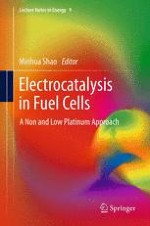2013 | Buch
Über dieses Buch
Fuel cells are one of the most promising clean energy conversion devices that can solve the environmental and energy problems in our society. However, the high platinum loading of fuel cells - and thus their high cost - prevents their commercialization. Non- or low- platinum electrocatalysts are needed to lower the fuel cell cost.
Electrocatalysis in Fuel Cells: A Non and Low Platinum Approach is a comprehensive book summarizing recent advances of electrocatalysis in oxygen reduction and alcohol oxidation, with a particular focus on non- and low-Pt electrocatalysts. All twenty four chapters were written by worldwide experts in their fields. The fundamentals and applications of novel electrocatalysts are discussed thoroughly in the book.
The book is geared toward researchers in the field, postgraduate students and lecturers, and scientists and engineers at fuel cell and automotive companies. It can even be a reference book for those who are interested in this area.
Anzeige
